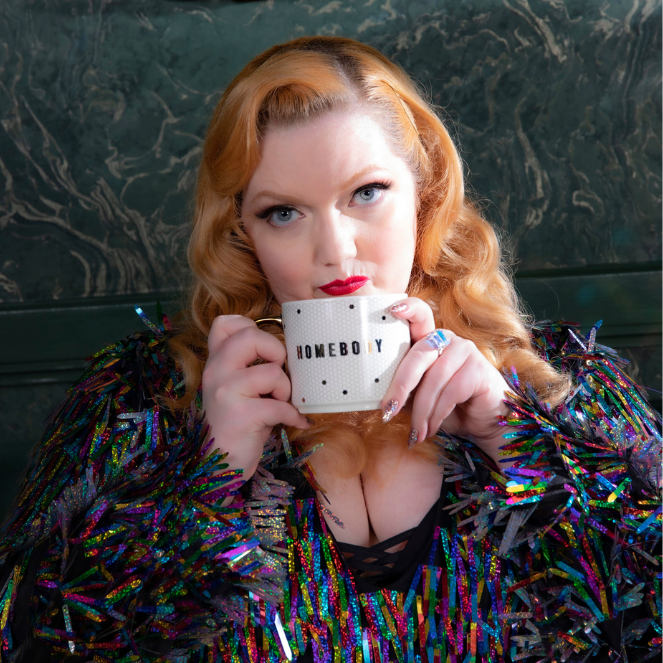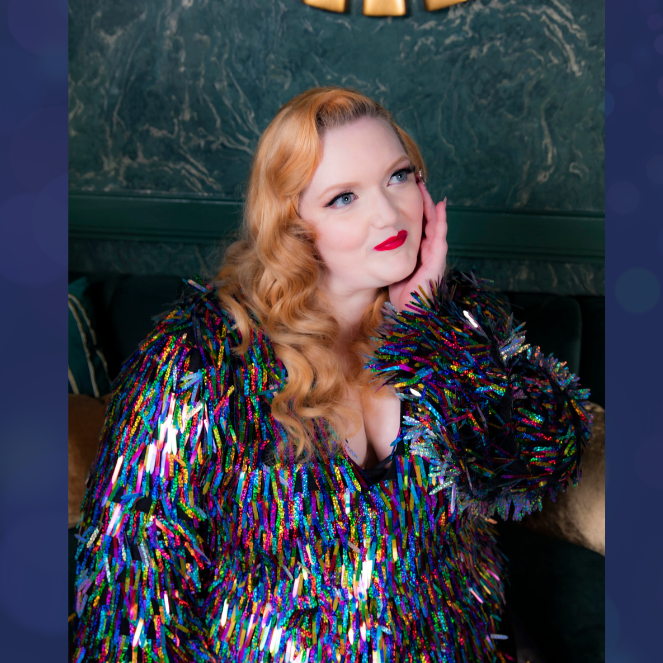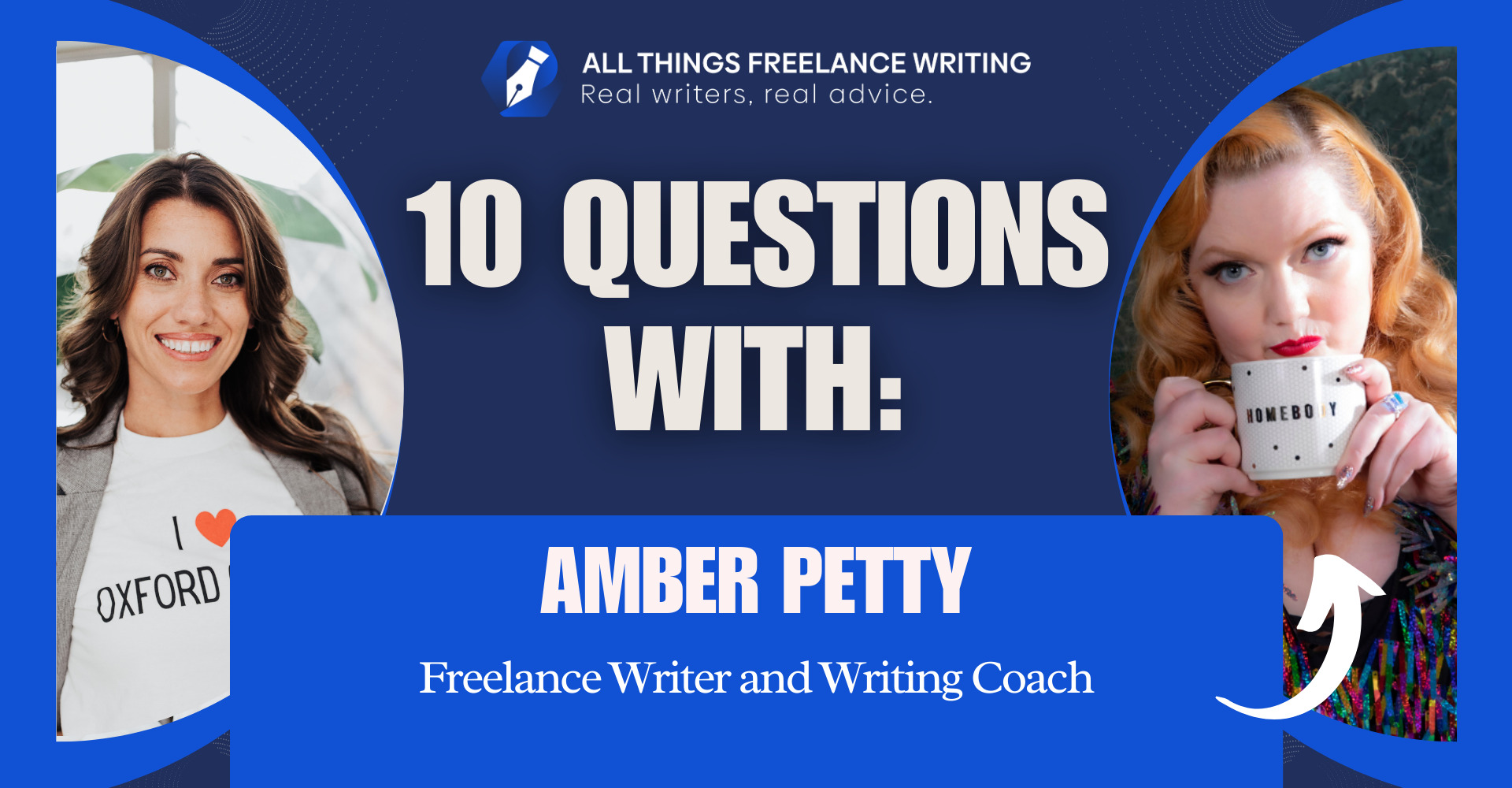- From: Originally from Puyallup, WA; lived in NYC from ages 17-30; and in Burbank, CA since then.
- Began freelance writing: 7 years ago
- About: Amber is a regular contributor to The New York Times, MTV, Thrillist, IFC, Bustle, Greatist, Healthline, Parade, and more. She also teaches Freelance Writing for Creatives, a 10-Week Course for freelance writers that helps students land big bylines of their own.
Thank you for joining us for our 10-question interview series, Amber! I’ve had so many people message me about how helpful your ATFW podcast episode (#4) was for them. I’m excited to feature you on the blog as well!
10 Questions with Amber Petty
Here are the 10 questions we have for you:
1: Can you share a bit about how and why you became a freelance writer?
I did what a lot of freelance writers do…spend 23 years training to be an actor!
I never considered writing much as a kid (aside from my occasional books of poetry and short stories), but I was 100% focused on acting. I was an actor in New York for a long time, then I moved to LA at 30, and needed a better part-time job. Something that wouldn’t take all my time or require me to open beers for already drunk people.
I read a lot of things online and knew about the entertainment business, so I figured I could write lists for places like Buzzfeed. After a few months, I found such satisfaction writing for small places, I’d get annoyed when a commercial audition would pop up and ruin my writing schedule. So, I left acting and wrote full-time.
2. What advice would you give to people 30+ looking to pivot into writing?
It’s easy to look at publications that have headlines like “Skinny Jeans Aren’t Cool Anymore, But for Some Reason the Clothes You Wore in High School are Back In!” and assume that everything is aimed at Gen Z and written by 20-year-olds. That’s not true!
Editors want to work with people who can turn things in on time and do a good job. Half the time, they don’t know how old you are. And, the more years on the Earth, the more interesting ideas and perspectives you have to share.
Also, editors are surprisingly patient. I worked for a few places and they had to tell me the proper usage of possessive apostrophes and tell me “the editor’s job isn’t to correct all your typos, please clean this up.” I got those notes at 31! But, I fixed the problems, kept turning things in on time, and kept getting work.
“Editors want to work with people who can turn things in on time and do a good job. Half the time, they don’t know how old you are.”
-Amber Petty
3. And, the big question — how did you land your first-ever writing gig and how long did it take?
My first writing job was for Interweave Knits where I wrote descriptions of knitting patterns. I found it through Craigslist about two months after I really started looking for writing jobs. Even though it didn’t pay much, as a knitter, I was desperate to get it.
After that, I got a job writing short snarky entertainment news pieces. I wrote 3 articles a day, 5 days a week, for $200 a month. Also on Craigslist. So, my start wasn’t glamorous. But within about 6 months, I made about $2,000 a month from writing (enough to pay my bills) and within a year, I consistently made $5,000 a month through writing.
4. Now you have many impressive bylines in pubs like The New York Times, Bustle, and Thrillest. Is there a secret to getting pitches accepted by these big players?

The only secret is to keep trying. Isn’t that boring? It’s true, though. The more you pitch, the better you get at it.
Something a little more helpful: Unless it’s a personal essay, don’t make the pitch about you. The editor isn’t that worried about your whole writing career or how you came up with the idea you’re pitching. They want to know how it will impact their audience. So, when you can focus on why the piece will speak to their readers, it helps you stand out.
Another little secret: You can’t embarrass yourself. Editors get tons of pitches every day. Even if yours isn’t great, they aren’t going to put your pitch on the office refrigerator with a “look at this idiot” sign. They won’t even remember your name, they’ll simply say no or click out of your email and move on.
So don’t worry about ruining your future chances with a “bad” pitch. They only remember when it’s good and you get so many chances to be good!
5. Next, when did you realize you wanted to move into the coaching space?
In 2020, I worked full-time as a copywriter for a makeup company. With all the economic insecurity, I wasn’t sure if my job would stick around. Plus, I’d been freelance most of my career (I had two full-time copywriting jobs that lasted a year a piece during my 7 years as a writer) and wanted to go back to it.
I also had a lot of friends who lost their acting work and their side jobs. I wanted to do a workshop to show people that they don’t have to depend on waiting tables for money, and let them know about lots of writing or other online jobs they could check out. I also thought “I don’t want to do this entirely for free, so maybe I’ll sell coaching.”
So, I did the webinar a few times and got 17 clients for a small coaching package. Though I intended to talk about all kinds of online jobs, it always went back to freelance writing (not shocking, since that’s where I had the most experience).
So, I put together a small paid workshop, then tested a 4-week class. I sold spots each time and I was shocked at how much I loved teaching in this context (I’d taught improv and voice and speech before, but never taught my own curriculum).
By 2021, I promised myself that if I saved $15,000, I would quit my job. I thought it would take a year if I was lucky. It took 2 months.
I absolutely love coaching and teaching classes. It’s so beautiful to help other people get bylines and feel the creative satisfaction writing can bring. Also, coaching allows me to be much pickier about who I write for (not that I don’t love writing about psoriasis rash, but tons of health SEO work wasn’t the biggest thrill).
“I absolutely love coaching and teaching classes. It’s so beautiful to help other people get bylines and feel the creative satisfaction writing can bring.”
-Amber Petty
6. For the freelance writers who are first starting out, what do you recommend they focus on in their first month?
I would make a spec piece, i.e. a short article in the style of a publication they might like to write for. Then, put that writing online. Medium, your own blog, just somewhere that’s easily linkable. After that, start pitching.
7. Where do you recommend writers look for pitching opportunities?
Sonia Weiser has a wonderful newsletter where she shares editor pitch requests from Twitter. You can get all that contact info (plus what editors are looking for) for only $4 a month. I’m not affiliated with Sonia in any way, just a big fan.
Even if an editor never asks for pitches, almost all publications are open to pitches from freelancers. See if your favorite place has a submission guide. If they don’t, simply find out the name and email of the editor and send them a pitch. It’s not weird!
Editors expect pitches and you don’t need to have any special resume to do it. Lots of my students got into places like Huffington Post, Insider, and Buzzfeed without any previous bylines.
8. Also, a burning question on the minds of many writers: What rates do you find are typical for most publications?

The range is huge! I just had a student get her third byline with the Texas Observer. Each piece paid about $1,200. A piece in Huffington Post personal essay can get you a ton of views and is a braggable byline, but they only pay about $125 for your story.
The $300 range is about average, though you still might find people paying $150 for an article (and you’ll also find people paying $500, $800, and up). Who Pays Writers is a great site to give you an idea of what publications pay.
9. I love your focus on helping writers overcome perfectionism…and the name of your latest course, “The Perfectionist’s Half-Assed Writing Spree.” When did you realize that perfectionism was a hurdle that holds many writers back?
When I went to therapy! It’s sort of a joke answer, but sort of true. I knew that I was always put off when people asked for “only the best stories” or “the content has to be gold.” I thought that my content was never gold, so I’d better not pitch anything.
As I started writing more, I found that editors were happy with my work even if it wasn’t “100%” to my perfectionistic brain.
As I started coaching, I realized it wasn’t just me, it was true for so many of my students. All these smart, wonderful people wind up second-guessing their ideas, where an overconfident blowhard just rides in, pitches a story without a care, and gets the byline. That’s so annoying.
As I encouraged students in class to think differently after their work and to frankly, not try so hard, it made a difference.
Now, I’m so excited to have a short course where the whole focus is on getting through that “it’s not good enough” or “you suck!” voice, so you can actually gain confidence in your writing and send more work out into the world. Let’s not leave the bylines to the blowhards, it’s time for perfectionists to get out there, too!
10. Lastly, what’s one piece of advice you’d give to the writers out there who are struggling with perfectionism and feeling like it’s slowing them down?
Every idea doesn’t need to be Pulitzer Prize-worthy. Yesterday, I spent 5 minutes reading “Smash or Trash – Hot White Guy Edition” on Buzzfeed. Though it was silly, it was still enjoyable and made my day a little more fun.
When you open up the range of possibilities from “I only write it if it’s the best thing ever” to “I’ll write if it’s something that sounds kind of fun or interesting,” you’ll be shocked how many more ideas you have and how much easier they are to write.
Stay in touch with Amber!
Where can people find you and learn from you?
- Get free job listings and other writing tips with my newsletter.
- My podcast Don’t Wait to Write has weekly 5-Minute Writing Exercises and short discussions of different writing topics.
- And I’m on Instagram: @ambernpetty
Thanks so much, Amber! As always, it was an absolute pleasure.


